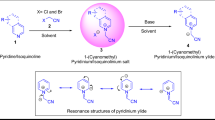Abstract
IN a recent communication1, the reaction between hydrazine and a 1-formimino-pyrazole (I) was reported. It was found that molecular cleavage resulted, the products being a substituted hydrazine and a 1-unsubstituted pyrazole. This rearrangement occurs either by cleavage of the 1-substituent with its attachment to the hydrazine (mode A), or by initial ring opening, with subsequent displacement of the aminoguanidine derivative from the resulting hydrazone (mode B).
Similar content being viewed by others
References
Scott, F. L., Murphy, C. M. B., and Reilly, J., Nature, [167, 1037 (1951)].
Unpublished notes.
Scott, F. L., O'Donovan, D. G., and Reilly, J., J. App. Chem. (in the press).
Author information
Authors and Affiliations
Rights and permissions
About this article
Cite this article
SCOTT, F., KENNEDY, M. & REILLY, J. A New Route to Substituted Guanidines. Nature 169, 72–73 (1952). https://doi.org/10.1038/169072a0
Issue Date:
DOI: https://doi.org/10.1038/169072a0
- Springer Nature Limited





